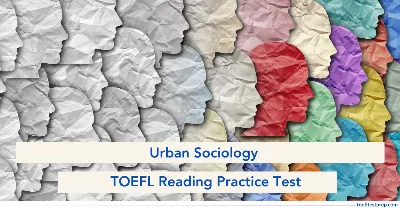Urban Sociology - TOEFL iBT® Reading Practice Test

"Improve your TOEFL Reading skills with practice passages on 'Urban Sociology,' examining urbanisation's effects on communities and lifestyles."
Key Highlights
Urban sociology is the study of social, political, and economic relationships within cities and urban spaces. It examines how people interact, organize, and shape their lives in densely populated areas and explores the various influences that urban environments have on individuals and communities.
In the context of a TOEFL reading test, a passage on urban sociology might cover how cities develop, the challenges and benefits of urbanization, and the societal trends that emerge as cities grow. This introduction sets the stage for exploring urban dynamics, such as the impact of migration, the rise of subcultures, and the socio-economic divides that often characterize urban life, offering a rich foundation for comprehension and analysis within an academic setting.
Reading Instructions
- You have 15 minutes to read the following passage and answer all 9 questions related to it.
- Most questions are worth 1 point, but the last question is worth more. The directions indicate how many points you will receive for that specific question.
- The specific section/paragraphs have been provided again with the question for ease of understanding and quick solution.
- Some questions include a word or phrase that is highlighted in the question as well as in the paragraph for quick reference.
Urban Sociology: Understanding City Dynamics
Urban sociology is a subfield of sociology that investigates the complex social, political,
and economic interactions of urban areas. As cities continue to grow and change, understanding urban life becomes increasingly important. Urban researchers explore various aspects of city life, including the relationships between individuals and their environments, the impact of urbanization on social structures, and the ways in which urban spaces are shaped by cultural, economic, and political forces. The study of urban sociology not only provides understandings of how cities function but also highlights the challenges and opportunities that arise in densely populated areas, particularly in the context of gobalization and technological advancement.
One of the foundational theories in urban sociology is the Chicago School of Sociology, which emerged in the early 20th century. Scholars such as Robert Park and Ernest Burgess posited that cities develop in a series of circular zones, each defined by distinct social and economic activities. This model suggests that urban areas expand outward from a central business district, with residential zones surrounding it. While this model has been influential, it has faced criticism for oversimplifying the complexities of urban growth and failing to account for the diverse experiences of urban residents. Subsequent theories, such as the multiple nuclei model proposed by Harris and Ullman in 1945, have sought to address these limitations by recognizing that cities can develop around multiple centers of activity rather than a single core. This shift in perspective reflects the increasing complexity of urban environments, particularly in the context of post-industrial cities.
The occurrence of urbanization has important effects on social relationships and community structures. As cities grow, they often experience increased social layering, with differences in wealth, access to resources, and opportunities becoming more pronounced. For instance, urban areas may exhibit stark contrasts between affluent neighborhoods and poor communities, leading to social tensions and conflicts. The rise of informal settlements, often referred to as slums, is a direct consequence of rapid urbanization, where inadequate
housing and lack of basic services worsen the situation for the urban poor. Furthermore, the influx of migrants into cities can lead to cultural diversity, which, while enriching, may also create challenges in social cohesion. Urban researchers study these interactions to understand how individuals manage their identities and relationships within the context of a rapidly changing urban landscape, particularly in multicultural settings.
Another critical aspect of urban sociology is the examination of urban space and its use. The design and organization of urban environments significantly influence social interactions and behaviors. Public spaces, such as parks, plazas, and streets, serve as arenas for social engagement while also reflecting broader societal values and power dynamics. For example, the distribution of resources for public amenities often reveals underlying differences, as wealthier areas may receive more investment than disadvantaged neighborhoods. The concept of "neighborhood upgrading" has gained prominence in urban studies, referring to the process by which wealthier individuals move into lower-income neighborhoods, leading to rising property values and the displacement of long-term residents. This phenomenon raises questions about the viability of urban communities and the preservation of cultural heritage, as original inhabitants may be forced to relocate due to economic pressures.
The role of technology in shaping urban life is another area of interest within urban sociology. The rise of digital technologies has transformed how individuals interact with their environments and each other. For instance, the rise of social media platforms has facilitated new forms of community building, allowing individuals to connect across geographical boundaries. However, this digital connectivity can also worsen existing differences, as access to technology is not uniformly distributed. Urban researchers investigate how these technological advancements influence social networks, civic engagement, and the overall quality of life in urban settings. Additionally, the integration of smart city initiatives, which use data and technology to improve urban services, presents both opportunities and challenges for urban governance and citizen participation. The potential for increased efficiency must be balanced against concerns regarding privacy and surveillance.
In conclusion, urban sociology provides a comprehensive structure for understanding the complexities of urban life. By examining the interplay between social structures, spatial dynamics, and technological advancements, urban researchers contribute to a deeper understanding of the challenges and opportunities that cities face in the 21st century. As urban areas continue to expand and evolve, the insights gained from urban sociology will be crucial for policymakers, urban planners, and community leaders seeking to create inclusive, sustainable, and lively urban environments. Also, the ongoing exploration of urban dynamics not only enriches academic discourse but also informs practical approaches to addressing pressing issues such as inequality, housing, and environmental sustainability. The questions that remain unanswered in urban sociology will continue to shape the discourse around urban development and social justice in the years to come.
Directions: Once you have read the passage, answer the following questions.
Paragraph 1
Urban sociology is a subfield of sociology that investigates the complex social, political, and economic interactions of urban areas. As cities continue to grow and change, understanding urban life becomes increasingly important. Urban researchers explore various aspects of city life, including the relationships between individuals and their environments, the impact of urbanization on social structures, and the ways in which urban spaces are shaped by cultural, economic, and political forces. The study of urban sociology not only provides understandings of how cities function but also highlights the challenges and opportunities that arise in densely populated areas, particularly in the context of globalization and technological advancement.
Factual Information Questions
- According to paragraph 1, what does urban sociology primarily investigate?
- The historical development of cities
- The interactions of urban areas
- The architectural designs of urban spaces
- The economic policies of urban governments
Negative Factual Information Questions
- The author mentions all of the following as aspects explored by urban researchers EXCEPT:
- It accurately represents all urban growth patterns.
- To illustrate the evolution of urban sociology theories
- To argue against the importance of urban sociology
- To provide a historical context for urban development
Paragraph 2
One of the foundational theories in urban sociology is the Chicago School of Sociology, which emerged in the early 20th century. Scholars such as Robert Park and Ernest Burgess posited that cities develop in a series of circular zones, each defined by distinct social and economic activities. This model suggests that urban areas expand outward from a central business district, with residential zones surrounding it. While this model has been influential, it has faced criticism for oversimplifying the complexities of urban growth and failing to account for the diverse experiences of urban residents. Subsequent theories, such as the multiple nuclei model proposed by Harris and Ullman in 1945, have sought to address these limitations by recognizing that cities can develop around multiple centres of activity rather than a single core. This shift in perspective reflects the increasing complexity of urban environments, particularly in the context of post-industrial cities.
Inference Questions
- What can be inferred about the Chicago School of Sociology's model of urban development?
- It accurately represents all urban growth patterns.
- It has been completely abandoned by modern sociologists.
- To argue against the importance of urban sociology
- To provide a historical context for urban development
Rhetorical Purpose Questions
- Why does the author mention the multiple nuclei model in paragraph 2?
- To highlight the success of the Chicago School of Sociology
- To illustrate the evolution of urban sociology theories
- To argue against the importance of urban sociology
- To provide a historical context for urban development
Paragraph 3
The occurrence of urbanisation has important effects on social relationships and community structures. As cities grow, they often experience increased social layering, with differences in wealth, access to resources, and opportunities becoming more pronounced. For instance, urban areas may exhibit stark contrasts between affluent neighbourhoods and poor communities, leading to social tensions and conflicts. The rise of informal settlements, often referred to as slums, is a direct consequence of rapid urbanisation, where inadequate housing and lack of basic services worsen the situation for the urban poor. Furthermore, the influx of migrants into cities can lead to cultural diversity, which, while enriching, may also create challenges in social cohesion. Urban researchers study these interactions to understand how individuals manage their identities and relationships within the context of a rapidly changing urban landscape, particularly in multicultural settings.
Vocabulary Questions
- The word layering in paragraph 3 is closest in meaning to:
- Arrangement
- Separation
- Overlapping
- Division
Sentence Simplification Questions
- Which of the sentences below best expresses the essential information in the following text from paragraph 3? As cities grow, they often experience increased social layering, with differences in wealth, access to resources, and opportunities becoming more pronounced.
- Cities grow and become more complex in terms of wealth and resources.
- Urban growth leads to a decrease in social differences.
- Wealth and resources become less important as cities grow.
- Social differences in cities become less noticeable as they expand
Paragraph 4
Another critical aspect of urban sociology is the examination of urban space and its use. The design and organisation of urban environments significantly \influence social interactions and behaviours. Public spaces, such as parks, plazas, and streets, serve as arenas for social engagement while also reflecting broader societal values and power dynamics. For example, the distribution of resources for public amenities often reveals underlying differences, as wealthier areas may receive more investment than disadvantaged neighbourhoods. The concept of "neighbourhood upgrading has gained prominence in urban studies, referring to the process by which wealthier individuals move into lower-income neighbourhoods, leading to rising property values and the displacement of long-term residents. This phenomenon raises questions about the viability of urban communities and the preservation of cultural heritage, as original inhabitants may be forced to relocate due to economic pressures.
Purpose of the Passage Questions
- What is the main purpose of paragraph 4?
- To discuss the importance of public spaces in urban areas
- To explain the concept of neighbourhood upgrading
- To highlight the impact of urban design on social interactions
- To argue against the development of urban spaces
Paragraph 5
The role of technology in shaping urban life is another area of interest within urban sociology. The rise of digital technologies has transformed how individuals interact with their environments and each other. For instance, the rise of social media platforms has facilitated new forms of community building, allowing individuals to connect across geographical boundaries. However, this digital connectivity can also worsen existing differences, as access to technology is not uniformly distributed. Urban researchers investigate how these technological advancements influence social networks, civic engagement, and the overall quality of life in urban settings. Additionally, the integration of smart city initiatives, which use data and technology to improve urban services, presents both opportunities and challenges for urban governance and citizen participation. The potential for increased efficiency must be balanced against concerns regarding privacy and surveillance.
Insert Missing Sentence Question
- In paragraph 5, there is a missing sentence. The paragraph is repeated below and shows four letters (A, B, C, and D) that indicate where the following sentence could be added. These disparities can lead to social fragmentation and exclusion.Where would the sentence best fit?
- The rise of digital technologies has transformed how individuals interact with their
environments and each other. - For instance, the rise of social media platforms has facilitated new forms of community
building, allowing individuals to connect across geographical boundaries. - However, this digital connectivity can also worsen existing differences, as access to
technology is not uniformly distributed. - Urban researchers investigate how these technological advancements influence social
networks, civic engagement, and the overall quality of life in urban settings.
- The rise of digital technologies has transformed how individuals interact with their
Prose Summary Questions
Directions: An introductory sentence for a brief summary of the passage is provided below. Complete the summary by selecting the THREE answer choices that express the most important ideas in the passage. Some sentences do not belong in the summary because they express ideas that are not presented in the passage or are minor ideas in the passage. This question is worth 2 points.
- Urban sociology examines the complex dynamics of urban life, focusing on various factors
that influence cities.- Urban sociology is a subfield that only focuses on economic factors.
- Policymakers and urban planners can benefit from insights gained from urban sociology.
- Urban areas are becoming less complex due to technological advancements.
- The study of urban sociology is irrelevant to modern city challenges.
Prose Summary Questions
- The ongoing exploration of urban dynamics not only enriches academic discourse but also informs practical approaches to addressing pressing issues such as inequality, housing, and environmental sustainability.
Answer Choices
- Urban sociology is a subfield that only focuses on economic factors.
- Policymakers and urban planners can benefit from insights gained from urban sociology.
- Urban areas are becoming less complex due to technological advancements.
- The study of urban sociology is irrelevant to modern city challenges.
Answer Key with Explanation for TOEFL Reading Passage - Urban Sociology
1. Answer: B
Explanation:The passage clearly states that urban sociology investigates the complex social, political, and economic interactions of urban areas. This encompasses a broad range of factors that influence urban life, making option B the most accurate choice.
2. Answer: C
Explanation:The passage discusses various aspects of urban life, including relationships, urbanization's impact on social structures, and cultural forces shaping urban spaces. However, it does not mention the role of rural areas in urban development, making option C the correct answer.
3. Answer: C
Explanation:The passage notes that while the Chicago Schools model has been influential, it has faced criticism for oversimplifying urban growth. This indicates that later theories have sought to address these limitations, supporting option C as the correct inference.
4. Answer: B
Explanation: The mention of the multiple nuclei model serves to show how urban sociology theories have evolved from the Chicago School's model, which was criticized for its simplicity. This illustrates the progression and increasing complexity of urban theories, making option B the best choice.
5. Answer: A
Explanation:In the context of the passage, layering" refers to the arrangement of social differences and structures within urban areas. It implies a systematic organisation of social classes and resources, making option A the most fitting synonym.
6. Answer: A
Explanation:This option captures the essence of the original sentence, which discusses how urban growth leads to increased complexity in social structures, particularly regarding wealth and resources. It succinctly summarises the main idea without altering its meaning.
7. Answer: C
Explanation: The paragraph discusses how the design and organisation of urban spaces influence social interactions and behaviours. While it touches on public spaces and neighbourhood upgrading, the overarching theme is the impact of urban design, making option C the most accurate choice.
8. Answer: C
Explanation:The sentence "These disparities can lead to social fragmentation and exclusion fits best after the statement about digital connectivity worsening existing differences. It logically follows the discussion of unequal access to technology, reinforcing the idea of social fragmentation.
9. Answer: A,B, and D
Explanation:These disparities can lead to social fragmentation and exclusion." fits best after the statement about digital connectivity worsening existing differences. It logically follows the discussion of unequal access to technology, reinforcing the idea of social fragmentation.
10. Answer: B
Explanation:This option aligns with the passages conclusion, which emphasises the relevance of urban sociology to real-world challenges faced by cities. It suggests that insights from urban sociology can guide policymakers and planners, making option B the most appropriate choice.
Also Read:
- Swimming Devices - TOEFL iBT® Reading Practice Questions with Answer Key
- Earth and Its Landscape - TOEFL iBT® Reading Practice Questions with Answer Key
- Facial Expressions and Emotions - TOEFL iBT® Reading Practice Questions with Answer Key
- La Loie - TOEFL Reading Practice Questions with Answer Key
- Icebergs - TOEFL Reading Practice Questions with Answer Key
Featured Articles

Marriage Across Cultures - TOEFL Reading Practice Test
Improve TOEFL Reading with passages on 'Marriage Across Cultures,' delving into unique traditions, values, and global perspectives on marriage.
July 15, 2025
Writing Center Services - TOEFL Speaking Practice Test with Answers (Integrated)
Prepare for the TOEFL Integrated Speaking section with a practice test on 'Writing Center Services' and learn to improve score in TOEFL exam.
July 15, 2025
Tutorial Room Booking - TOEFL Speaking Practice Test with Answers (Integrated)
Prepare for the TOEFL Integrated Speaking section with a practice test on 'Tutorial Room Booking ' and learn to improve score in TOEFL exam.
July 15, 2025
Textbook Rental System - TOEFL Speaking Practice Test with Answers (Integrated)
Prepare for the TOEFL Integrated Speaking section with a practice test on 'Textbook Rental System' and learn to improve score in TOEFL exam.
July 15, 2025